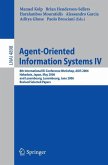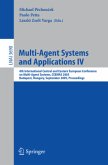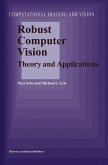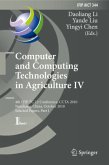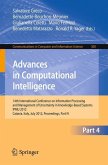Mario G. Piattini / J.B. Filipe / J. Braz (Hgg.)
Enterprise Information Systems IV
Herausgegeben:Piattini, Mario G.; Filipe, J. B.; Braz, J.
Mario G. Piattini / J.B. Filipe / J. Braz (Hgg.)
Enterprise Information Systems IV
Herausgegeben:Piattini, Mario G.; Filipe, J. B.; Braz, J.
- Gebundenes Buch
- Merkliste
- Auf die Merkliste
- Bewerten Bewerten
- Teilen
- Produkt teilen
- Produkterinnerung
- Produkterinnerung
The purpose of the 4th International Conference on Enterprise Information Systems (ICEIS) was to bring together researchers, engineers and practitioners interested in the advances and business applications of information systems. The research papers focused on real world applications covering four main themes: Enterprise Database Applications, Artificial Intelligence Applications and Decision Support Systems, Systems Analysis and Specification, and Internet and Electronic Commerce. This book will be of interest to information technology professionals, especially those working on systems…mehr
Andere Kunden interessierten sich auch für
![Agent-Oriented Information Systems IV Agent-Oriented Information Systems IV]() Agent-Oriented Information Systems IV39,99 €
Agent-Oriented Information Systems IV39,99 €![Cooperative Information Agents IV - The Future of Information Agents in Cyberspace Cooperative Information Agents IV - The Future of Information Agents in Cyberspace]() Matthias Klusch / Larry Kerschberg (eds.)Cooperative Information Agents IV - The Future of Information Agents in Cyberspace41,99 €
Matthias Klusch / Larry Kerschberg (eds.)Cooperative Information Agents IV - The Future of Information Agents in Cyberspace41,99 €![Agent Environments for Multi-Agent Systems IV Agent Environments for Multi-Agent Systems IV]() Agent Environments for Multi-Agent Systems IV37,99 €
Agent Environments for Multi-Agent Systems IV37,99 €![Multi-Agent Systems and Applications IV Multi-Agent Systems and Applications IV]() Michal Pechoucek / Paolo Petta / Laszlo Zsolt Varga (eds.)Multi-Agent Systems and Applications IV81,99 €
Michal Pechoucek / Paolo Petta / Laszlo Zsolt Varga (eds.)Multi-Agent Systems and Applications IV81,99 €![Robust Computer Vision Robust Computer Vision]() N. SebeRobust Computer Vision81,99 €
N. SebeRobust Computer Vision81,99 €![Computer and Computing Technologies in Agriculture IV Computer and Computing Technologies in Agriculture IV]() Computer and Computing Technologies in Agriculture IV82,99 €
Computer and Computing Technologies in Agriculture IV82,99 €![Advances in Computational Intelligence, Part IV Advances in Computational Intelligence, Part IV]() Advances in Computational Intelligence, Part IV42,99 €
Advances in Computational Intelligence, Part IV42,99 €-
-
-
The purpose of the 4th International Conference on Enterprise Information Systems (ICEIS) was to bring together researchers, engineers and practitioners interested in the advances and business applications of information systems. The research papers focused on real world applications covering four main themes: Enterprise Database Applications, Artificial Intelligence Applications and Decision Support Systems, Systems Analysis and Specification, and Internet and Electronic Commerce.
This book will be of interest to information technology professionals, especially those working on systems integration, databases, decision support systems or electronic commerce. It will also be of use to middle managers who need to work with information systems and require knowledge of current trends in development methods and applications.
Hinweis: Dieser Artikel kann nur an eine deutsche Lieferadresse ausgeliefert werden.
This book will be of interest to information technology professionals, especially those working on systems integration, databases, decision support systems or electronic commerce. It will also be of use to middle managers who need to work with information systems and require knowledge of current trends in development methods and applications.
Hinweis: Dieser Artikel kann nur an eine deutsche Lieferadresse ausgeliefert werden.
Produktdetails
- Produktdetails
- Verlag: Springer / Springer Netherlands
- Artikelnr. des Verlages: 978-1-4020-1086-6
- 2003
- Seitenzahl: 308
- Erscheinungstermin: 31. Dezember 2002
- Englisch
- Abmessung: 241mm x 160mm x 22mm
- Gewicht: 608g
- ISBN-13: 9781402010866
- ISBN-10: 1402010869
- Artikelnr.: 22310297
- Herstellerkennzeichnung Die Herstellerinformationen sind derzeit nicht verfügbar.
- Verlag: Springer / Springer Netherlands
- Artikelnr. des Verlages: 978-1-4020-1086-6
- 2003
- Seitenzahl: 308
- Erscheinungstermin: 31. Dezember 2002
- Englisch
- Abmessung: 241mm x 160mm x 22mm
- Gewicht: 608g
- ISBN-13: 9781402010866
- ISBN-10: 1402010869
- Artikelnr.: 22310297
- Herstellerkennzeichnung Die Herstellerinformationen sind derzeit nicht verfügbar.
Preface. Conference Committee. Invited Papers: E-commerce concerns: do we
need to change some systems?; N. Chapin. E-workcell: a virtual reality
web-based decision support system for assembly line planning; O. Gusikhin,
et al. New technology great opportunities: how to exploit them; I. Bider,
M. Khomyakov. How informatics can solve methodological gap in e-business
modeling; M.J. Matsumoto. Part 1: Databases and Information Systems
Integration. Data representation in industrial systems; C. Raibulet, C.
Demartini. An XML-based virtual patient records system for healthcare
enterprises; Zhang Xiaoou, Pung Hung Keng. Using full match classes for
self-maintenance of mediated views; V. Magalhães, et al. A system for data
change propagation in heterogeneous information systems; C. Constantinescu,
et al. Semi-automatic wrapper generation and adaption: living with
heterogeneity in a market environment; M. Christoffel, et al. FSQL: a
flexible query language for data mining; R.A. Carrasco, et al. Using data
mining techniques to analyze correspondence between user and scientific
knowledge in an agricultural environment; D. Sánchez, et al.
Implementation of fuzzy classification query language in relational
databases using stored procedures; Y. Veryha. Part 2: Artificial
Intelligence and Decision Support Systems. Storage of fuzzy information in
continuous classifying associative memories; A.B. Bailón, et al. A
case-based expert system for estimating the cost of refurbishing
construction buildings; F. Marir, et al. Proof running two state-of-the-art
pattern recognition techniques in the field of direct marketing; S. Viaene,
et al. Simple decision support system based on fuzzy repertory table; J.J.
Castro-Schez, et al. Supporting the optimisation of distributed data mining
by predicting application run times; S, Krishnaswamy, et al. Part 3:
Information Systems Analysis and Specification. Business modelling with
UML: distilling directions for further research; S.de Cesare, et al.
Updating data in GIS: how to maintain database consistency?; H.
Kadri-Dahmani, A. Osmani. Analysis of the relation between the prescriptive
and descriptive approaches of the information system planning; J.L.N. Audy.
Designing business processes and communication structures for e-business
using ontology-based enterprise models with mathematical models; H.M. Kim,
K.D. Tham. Ontologies supporting business process re-engineering; A.
Galatescu, T. Greceanu. Sequence constraints in business modelling and
business process modelling; M. Snoeck. Analysing communication in the
context of a software production organisation; M.C.C. Baranauskas, et al.
A functional size measurement method for event-based object-oriented
enterprise models; G. Poels. Conceptual architecture for the assessment and
improvement of software maintenance; F. García, et al. A tool for assessing
the consistency of websites; S. Steinau, et al. Part 4: Internet Computing
and Electronic Commerce. An automated approach to quality-aware web
publications; A. Ruiz, et al. Internet technology as a business tool: a
test of its effectiveness; S. Bruque. Towards extended price models in XML
standards for electronic product catalogues; O. Kelkar, et al. A
semi-universal e-commerce agent: domain-dependant information gathering;
A. Pivk, M. Gams. E-commerce business practices in the EU; H. Jahankhani,
S.A. Alexis. Automatic verification of security in payment protocols for
electronic commerce; M. Panti, et al. Staged implementation of e-business
networks through ERP: a case study of Siemens (1998 2001); C.G. Ash, J.M.
Burn. Author Index.
need to change some systems?; N. Chapin. E-workcell: a virtual reality
web-based decision support system for assembly line planning; O. Gusikhin,
et al. New technology great opportunities: how to exploit them; I. Bider,
M. Khomyakov. How informatics can solve methodological gap in e-business
modeling; M.J. Matsumoto. Part 1: Databases and Information Systems
Integration. Data representation in industrial systems; C. Raibulet, C.
Demartini. An XML-based virtual patient records system for healthcare
enterprises; Zhang Xiaoou, Pung Hung Keng. Using full match classes for
self-maintenance of mediated views; V. Magalhães, et al. A system for data
change propagation in heterogeneous information systems; C. Constantinescu,
et al. Semi-automatic wrapper generation and adaption: living with
heterogeneity in a market environment; M. Christoffel, et al. FSQL: a
flexible query language for data mining; R.A. Carrasco, et al. Using data
mining techniques to analyze correspondence between user and scientific
knowledge in an agricultural environment; D. Sánchez, et al.
Implementation of fuzzy classification query language in relational
databases using stored procedures; Y. Veryha. Part 2: Artificial
Intelligence and Decision Support Systems. Storage of fuzzy information in
continuous classifying associative memories; A.B. Bailón, et al. A
case-based expert system for estimating the cost of refurbishing
construction buildings; F. Marir, et al. Proof running two state-of-the-art
pattern recognition techniques in the field of direct marketing; S. Viaene,
et al. Simple decision support system based on fuzzy repertory table; J.J.
Castro-Schez, et al. Supporting the optimisation of distributed data mining
by predicting application run times; S, Krishnaswamy, et al. Part 3:
Information Systems Analysis and Specification. Business modelling with
UML: distilling directions for further research; S.de Cesare, et al.
Updating data in GIS: how to maintain database consistency?; H.
Kadri-Dahmani, A. Osmani. Analysis of the relation between the prescriptive
and descriptive approaches of the information system planning; J.L.N. Audy.
Designing business processes and communication structures for e-business
using ontology-based enterprise models with mathematical models; H.M. Kim,
K.D. Tham. Ontologies supporting business process re-engineering; A.
Galatescu, T. Greceanu. Sequence constraints in business modelling and
business process modelling; M. Snoeck. Analysing communication in the
context of a software production organisation; M.C.C. Baranauskas, et al.
A functional size measurement method for event-based object-oriented
enterprise models; G. Poels. Conceptual architecture for the assessment and
improvement of software maintenance; F. García, et al. A tool for assessing
the consistency of websites; S. Steinau, et al. Part 4: Internet Computing
and Electronic Commerce. An automated approach to quality-aware web
publications; A. Ruiz, et al. Internet technology as a business tool: a
test of its effectiveness; S. Bruque. Towards extended price models in XML
standards for electronic product catalogues; O. Kelkar, et al. A
semi-universal e-commerce agent: domain-dependant information gathering;
A. Pivk, M. Gams. E-commerce business practices in the EU; H. Jahankhani,
S.A. Alexis. Automatic verification of security in payment protocols for
electronic commerce; M. Panti, et al. Staged implementation of e-business
networks through ERP: a case study of Siemens (1998 2001); C.G. Ash, J.M.
Burn. Author Index.
Preface. Conference Committee. Invited Papers: E-commerce concerns: do we
need to change some systems?; N. Chapin. E-workcell: a virtual reality
web-based decision support system for assembly line planning; O. Gusikhin,
et al. New technology great opportunities: how to exploit them; I. Bider,
M. Khomyakov. How informatics can solve methodological gap in e-business
modeling; M.J. Matsumoto. Part 1: Databases and Information Systems
Integration. Data representation in industrial systems; C. Raibulet, C.
Demartini. An XML-based virtual patient records system for healthcare
enterprises; Zhang Xiaoou, Pung Hung Keng. Using full match classes for
self-maintenance of mediated views; V. Magalhães, et al. A system for data
change propagation in heterogeneous information systems; C. Constantinescu,
et al. Semi-automatic wrapper generation and adaption: living with
heterogeneity in a market environment; M. Christoffel, et al. FSQL: a
flexible query language for data mining; R.A. Carrasco, et al. Using data
mining techniques to analyze correspondence between user and scientific
knowledge in an agricultural environment; D. Sánchez, et al.
Implementation of fuzzy classification query language in relational
databases using stored procedures; Y. Veryha. Part 2: Artificial
Intelligence and Decision Support Systems. Storage of fuzzy information in
continuous classifying associative memories; A.B. Bailón, et al. A
case-based expert system for estimating the cost of refurbishing
construction buildings; F. Marir, et al. Proof running two state-of-the-art
pattern recognition techniques in the field of direct marketing; S. Viaene,
et al. Simple decision support system based on fuzzy repertory table; J.J.
Castro-Schez, et al. Supporting the optimisation of distributed data mining
by predicting application run times; S, Krishnaswamy, et al. Part 3:
Information Systems Analysis and Specification. Business modelling with
UML: distilling directions for further research; S.de Cesare, et al.
Updating data in GIS: how to maintain database consistency?; H.
Kadri-Dahmani, A. Osmani. Analysis of the relation between the prescriptive
and descriptive approaches of the information system planning; J.L.N. Audy.
Designing business processes and communication structures for e-business
using ontology-based enterprise models with mathematical models; H.M. Kim,
K.D. Tham. Ontologies supporting business process re-engineering; A.
Galatescu, T. Greceanu. Sequence constraints in business modelling and
business process modelling; M. Snoeck. Analysing communication in the
context of a software production organisation; M.C.C. Baranauskas, et al.
A functional size measurement method for event-based object-oriented
enterprise models; G. Poels. Conceptual architecture for the assessment and
improvement of software maintenance; F. García, et al. A tool for assessing
the consistency of websites; S. Steinau, et al. Part 4: Internet Computing
and Electronic Commerce. An automated approach to quality-aware web
publications; A. Ruiz, et al. Internet technology as a business tool: a
test of its effectiveness; S. Bruque. Towards extended price models in XML
standards for electronic product catalogues; O. Kelkar, et al. A
semi-universal e-commerce agent: domain-dependant information gathering;
A. Pivk, M. Gams. E-commerce business practices in the EU; H. Jahankhani,
S.A. Alexis. Automatic verification of security in payment protocols for
electronic commerce; M. Panti, et al. Staged implementation of e-business
networks through ERP: a case study of Siemens (1998 2001); C.G. Ash, J.M.
Burn. Author Index.
need to change some systems?; N. Chapin. E-workcell: a virtual reality
web-based decision support system for assembly line planning; O. Gusikhin,
et al. New technology great opportunities: how to exploit them; I. Bider,
M. Khomyakov. How informatics can solve methodological gap in e-business
modeling; M.J. Matsumoto. Part 1: Databases and Information Systems
Integration. Data representation in industrial systems; C. Raibulet, C.
Demartini. An XML-based virtual patient records system for healthcare
enterprises; Zhang Xiaoou, Pung Hung Keng. Using full match classes for
self-maintenance of mediated views; V. Magalhães, et al. A system for data
change propagation in heterogeneous information systems; C. Constantinescu,
et al. Semi-automatic wrapper generation and adaption: living with
heterogeneity in a market environment; M. Christoffel, et al. FSQL: a
flexible query language for data mining; R.A. Carrasco, et al. Using data
mining techniques to analyze correspondence between user and scientific
knowledge in an agricultural environment; D. Sánchez, et al.
Implementation of fuzzy classification query language in relational
databases using stored procedures; Y. Veryha. Part 2: Artificial
Intelligence and Decision Support Systems. Storage of fuzzy information in
continuous classifying associative memories; A.B. Bailón, et al. A
case-based expert system for estimating the cost of refurbishing
construction buildings; F. Marir, et al. Proof running two state-of-the-art
pattern recognition techniques in the field of direct marketing; S. Viaene,
et al. Simple decision support system based on fuzzy repertory table; J.J.
Castro-Schez, et al. Supporting the optimisation of distributed data mining
by predicting application run times; S, Krishnaswamy, et al. Part 3:
Information Systems Analysis and Specification. Business modelling with
UML: distilling directions for further research; S.de Cesare, et al.
Updating data in GIS: how to maintain database consistency?; H.
Kadri-Dahmani, A. Osmani. Analysis of the relation between the prescriptive
and descriptive approaches of the information system planning; J.L.N. Audy.
Designing business processes and communication structures for e-business
using ontology-based enterprise models with mathematical models; H.M. Kim,
K.D. Tham. Ontologies supporting business process re-engineering; A.
Galatescu, T. Greceanu. Sequence constraints in business modelling and
business process modelling; M. Snoeck. Analysing communication in the
context of a software production organisation; M.C.C. Baranauskas, et al.
A functional size measurement method for event-based object-oriented
enterprise models; G. Poels. Conceptual architecture for the assessment and
improvement of software maintenance; F. García, et al. A tool for assessing
the consistency of websites; S. Steinau, et al. Part 4: Internet Computing
and Electronic Commerce. An automated approach to quality-aware web
publications; A. Ruiz, et al. Internet technology as a business tool: a
test of its effectiveness; S. Bruque. Towards extended price models in XML
standards for electronic product catalogues; O. Kelkar, et al. A
semi-universal e-commerce agent: domain-dependant information gathering;
A. Pivk, M. Gams. E-commerce business practices in the EU; H. Jahankhani,
S.A. Alexis. Automatic verification of security in payment protocols for
electronic commerce; M. Panti, et al. Staged implementation of e-business
networks through ERP: a case study of Siemens (1998 2001); C.G. Ash, J.M.
Burn. Author Index.


